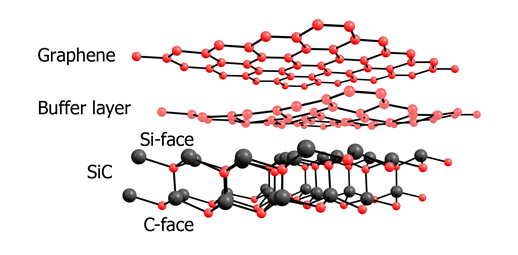Structure and Method of Epitaxial Growth of Nano Graphene on SiC Surface (Based on Nano-Microelectronics PhD) (Educational-Research Ph.D.)
Researcher and author: PhD student Afshin Rashid
Note: In the epitaxial growth method on a high temperature SiC surface, one can achieve monolayer or multilayer graphene. This method requires high temperatures above 1100 degrees Celsius. At this temperature the carbon source decomposes.
Graphene is a two-dimensional form of carbon atoms with a hybrid sp that is arranged in a hexagonal lattice structure and is known to be the thinnest material with a thickness of 1.95 nm . On a graphene plate, each carbon atom is bonded to another 9 carbon atoms. These three links are on one plate and the angles between them are equal to 421 °. In this case, the carbon atoms are in a position to form a network of regular hexagons ideally. The carbon-carbon bond length in graphene is about 1.412 nm. On a graphene plate, each carbon atom has an orbital off the plate. This orbital is a good place to link to some groups Factor as well as hydrogen atoms. The bond between the carbon atoms in the covalent plane is very strong. Therefore, graphene is very strong and carbon nanotubes are expected to be very strong. Graphite is a well-known and widely used carbon material that is formed by overlapping graphene layers and forming a regular structure. Another way to produce graphene is to remove the graphite layers to make them graphene. What holds the graphene layers together is the van der Waals links between them. This link is very weak. Therefore, graphene layers can easily slip over one another. Graphene layers from 9 to 41 layers are called low-layer graphene and between 41 to 91 layers are multilayer graphene, 6 thick graphene or thin graphite nanocrystals.
Since the sublimation rate of silicon is higher than carbon, the excess carbon remains on the surface, which forms carbon nanofibers after re-fabrication. These materials are called coke. These materials are considered a catalytic toxin, which is why graphene synthesis is not suitable for catalytic applications in this way . Another disadvantage of this method is the high structural defects in the layers. In addition, it is difficult to move to other platforms . It also requires high vacuum conditions and is a costly method.
Conclusion :
The size and physical shape of nanomaterials and their interatomic bonds are important parameters that have a significant impact on nanometer-sized material properties . Length, diameter, arrangement of atoms in the structure of nanotubes, structural defects, number of walls are important factors that affect the properties of nanotubes. Carbon nanotubes are one-atom-thick, hollow cylindrical carbon plates , and the arrangement of carbon atoms on the wall of this cylindrical structure is exactly similar to the carbon structure on graphite plates. In graphite hexagonal carbon is arranged side by side. If we cut a single-layer nanotube along the length, a plate of carbon atoms called graphene is obtained. The most recent altered form of carbon is graphene.




